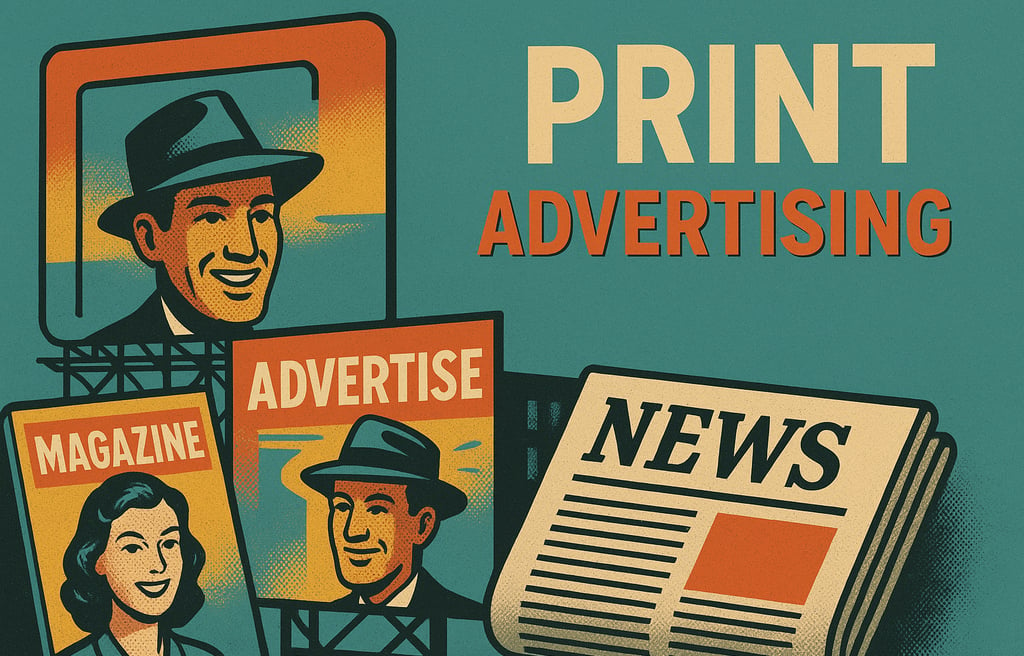Is Print Advertising Dead?
Does print advertising have a place in your marketing strategy in our screen-obsessed world?
MARKETING STRATEGYADVERTISING


Is Print Advertising Dead?
In a world where we are exposed to almost constant digital marketing, it’s tempting to assume that print advertising has met its demise. We live in an era where we are glued to our screens, and so online ads, social media promotions, and influencer marketing seem to dominate the advertising space. But is print advertising truly a thing of the past? Not quite. While it no longer holds the monopoly it once did (I used to place hundreds of thousands of pounds’ worth of press ads for clients back in the day), print advertising remains a powerful tool—especially when used strategically alongside digital campaigns.
The Tangible Appeal of Print
One of print’s biggest strengths is its physical presence. Unlike digital ads that vanish with a click, a well-crafted newspaper advert or magazine spread has staying power. It engages multiple senses—sight, touch, and even smell—creating a memorable experience that digital simply cannot replicate.
Ads in print also add value as a typical magazine is read by 2-3 people, and on average a newspaper could be as many as 3-5 people. Magazines also have ‘coffee table appeal’, that is to say they can sit around for weeks or even months being read and reread. If it makes its way to somewhere like a GP waiting room, then it could last years.
Print also benefits from a sense of credibility. In an online world where misinformation spreads rapidly and digital ads can feel intrusive, print retains a certain trustworthiness. Studies suggest that printed materials are perceived as more legitimate and authoritative compared to online promotions. For law firms, luxury brands, and niche industries, this trust factor makes print a valuable part of a marketing strategy
Print’s Role in Marketing Specific Markets
Print advertising continues to thrive in certain demographics and industries. Luxury brands, for example, leverage print to convey exclusivity and craftsmanship, placing elegant ads in high-end magazines. Local businesses still rely on newspapers, parish magazines, and direct mail to target nearby customers in a way that digital often struggles to replicate.
Additionally, print remains a strong player in niche markets. Industry-specific publications ensure ads reach an engaged, relevant audience—something broader digital platforms can't always guarantee. Legal publications, trade magazines, and specialised journals still command strong readerships, making them an effective advertising channel for professionals aiming to build credibility.
Print Advertising in the Digital Age
Rather than competing with digital, print can work alongside it for maximum impact. Integrated campaigns that bridge the gap between print and digital enhance engagement, offering the best of both worlds. Examples include:
QR Codes: Printed materials can direct readers to websites, exclusive content, or social media pages. Please don’t use QR codes in your digital ads!
Personalised URLs: Unique web addresses in print ads can help track engagement and drive traffic.
Social Media Mentions: Encouraging print readers to follow brands online creates cross-channel engagement.
Print also provides relief from screen fatigue. In an age where consumers are bombarded with digital ads, a well-placed printed ad offers an alternative—no pop-ups, no distractions, just the message in its purest form.
Is It Worth the Investment?
While print advertising has its advantages, it’s not without challenges. Tracking ROI is undoubtedly more complex than digital ads, which offer real-time analytics. Costs for print advertising can also be higher, requiring a strategic approach to choosing your media.
However, when combined with digital, print advertising can enhance brand recognition, audience trust, and engagement. The key lies in using it for what it does best—credibility, high-impact storytelling, and targeted outreach.
Conclusion
So, is print advertising dead? Far from it. While digital dominates modern marketing, print still holds a unique place in branding, trust-building, and high-engagement campaigns. The most successful advertisers don’t see print and digital as rivals—they use them together to create a seamless, powerful experience for consumers as part of their marketing strategy.


